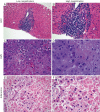Diagnosis and differential diagnosis of hepatic graft versus host disease (GVHD)
- PMID: 27034810
- PMCID: PMC4783620
- DOI: 10.3978/j.issn.2078-6891.2015.036
Diagnosis and differential diagnosis of hepatic graft versus host disease (GVHD)
Abstract
Graft versus host disease (GVHD) is a common complication following allogeneic hematopoietic cell transplantation (HCT) that typically manifests as injury to the skin, gastrointestinal mucosa, and liver. In some cases, hepatic GVHD may be histologically indistinguishable from other disorders such as infection and drug-induced liver injury (DILI). Additionally, clinical signs and symptoms are frequently confounded by the superimposed effects of pretransplant chemoradiotherapy, immunotherapy (IT) (targeted to the underlying malignancy), GVHD prophylaxis, and infection. Thus, careful attention to and correlation with clinical findings, laboratory values, and histologic features is essential for diagnosis. This review, aimed at the practicing pathologist, will discuss current clinical and histologic criteria for GVHD, the approach to diagnosis of hepatic GVHD, and features helpful for distinguishing it from other entities in the differential diagnosis.
Keywords: Hematopoietic cell transplantation (HCT); drug-induced liver injury (DILI); graft versus host disease (GVHD); hepatic lymphoma; immunotherapy (IT); post-transplant lymphoproliferative disorder (PTLD); veno-occlusive hepatic disease.
Conflict of interest statement
Figures




References
-
- Kim BK, Chung KW, Sun HS, et al. Liver disease during the first post-transplant year in bone marrow transplantation recipients: retrospective study. Bone Marrow Transplant 2000;26:193-7. - PubMed
-
- Levitsky J, Sorrell MF. Hepatic complications of hematopoietic cell transplantation. Curr Gastroenterol Rep 2007;9:60-5. - PubMed
-
- Kambham N, Higgins JP, Sundram U, et al. Hematopoietic stem cell transplantation: graft versus host disease and pathology of gastrointestinal tract, liver, and lung. Adv Anat Pathol 2014;21:301-20. - PubMed
